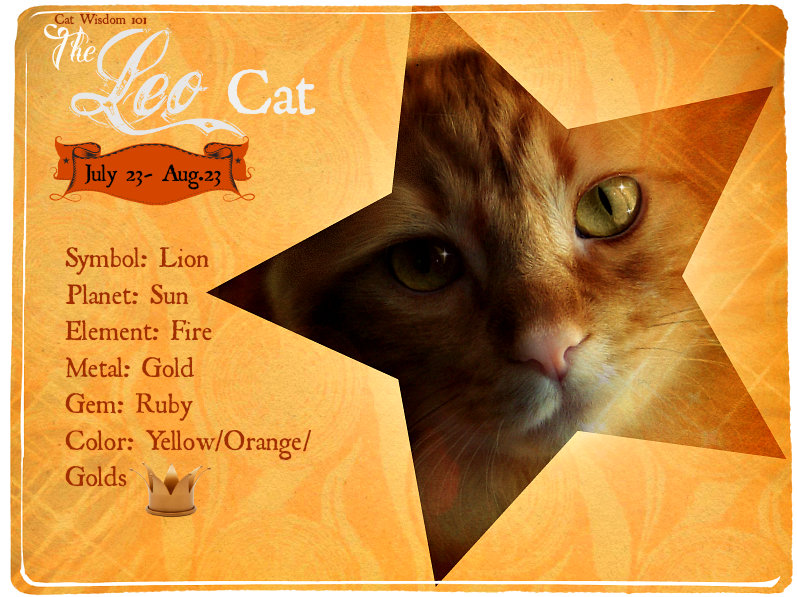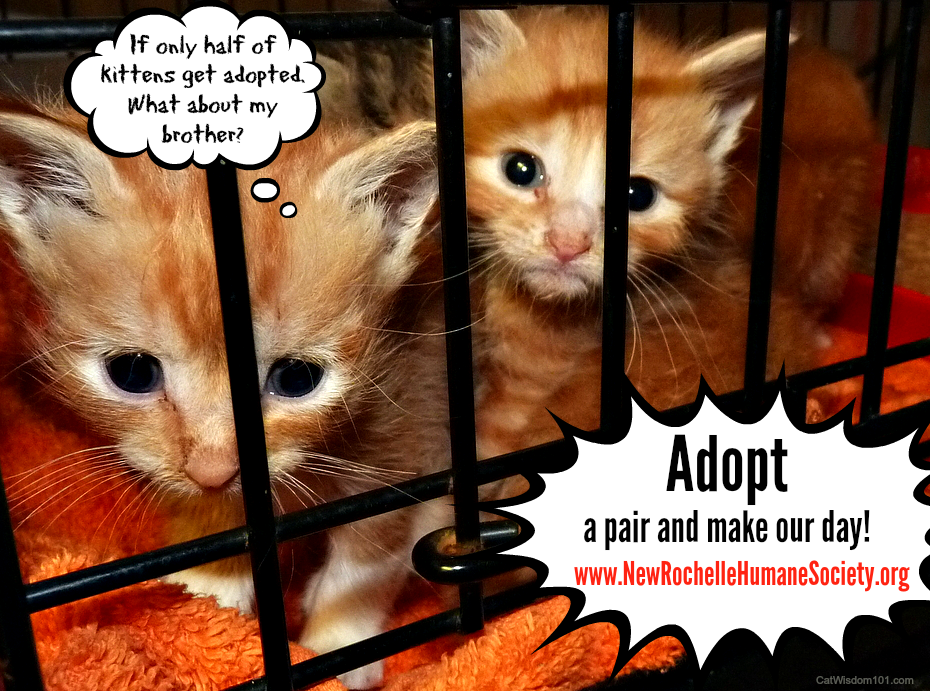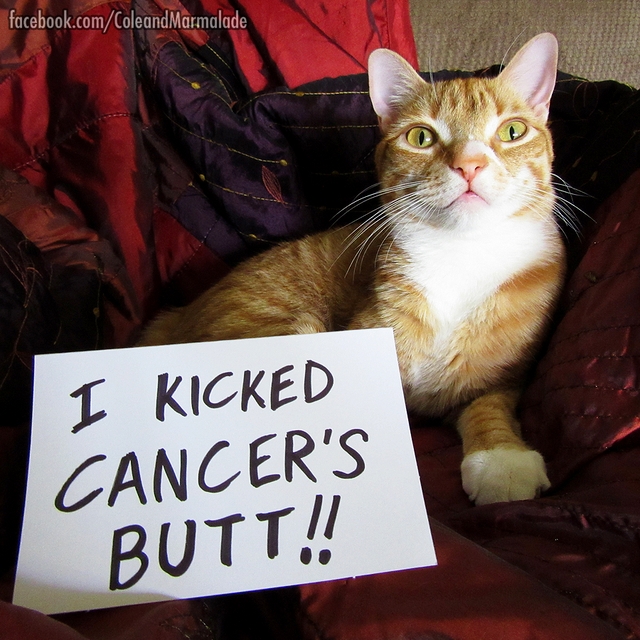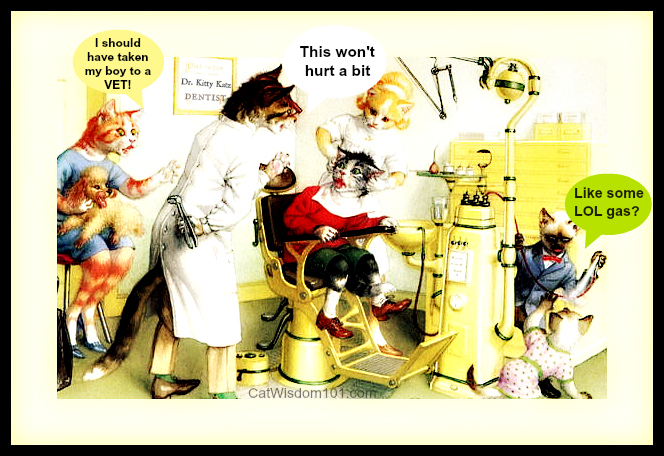
How To Examine Your Cat In Between Vet Visits
Most cats see their vet once or twice a year leaving ample opportunity for symptoms to develop. We’re re-posting part of a post from last year. Our primary vet, Dr. Rich Goldstein came over yesterday to check out Merlin. There’s something magical about a mobile clinic on wheels. A few steps outdoors on a muggy day with Merlin in our arms and poof, up two steps to an air-conditioned clinic. Geriatric cats like Merlin require more frequent vet visits but there’s no magic wand to turn back time.
It’s awe-inspiring to observe an old-school vet and feline specialist like Dr. G. at work. I always learn something new. He showed me how to palpate Merlin’s knee so I could see for myself a swelling likely from arthritis. I’d noticed him slowing down when walking and climbing stairs but he didn’t favor one side or limp and I suspected nothing amiss.
Cats are notorious for hiding any sign of illness. It’s a survival mechanism hard-wired in their DNA.
Observing a cat in action, walking, jumping, climbing, sitting offers clues but I find the easiest way to detect something suspicious is to compare one side or part of the anatomy with another. In this case, one leg and then the other.
One thing we can’t hide from is the scale. Merlin was down a pound, largely from being dehydrated and from losing muscle mass from kidney disease. That means more frequent sub-q fluids. We’ve gone from once to twice a week and now every second day. Eventually (hopefully not for a while!) it’ll be daily. I know to check for dehydration by tenting the skin at the scruff of the neck and then letting go. With a well-hydrated cat it’ll snap back within 2 seconds. Another clue was Merlin’s constipation. It’s rare for a well-hydrated cat to be constipated. What we and all cat parents can do provide quality of care in between vet visits.
Merlin is in decline but as Dr. G. says, “He’s doing well for a 100-year-old man.”
This guest post is timely and I hope helps you understand your cat on a deeper level. As a holistic practitioner, I look at the whole picture. There is the scientific and practical info from a vet but not all vets subscribe to alternative or complementary healing. I like to use supplements and energy healing like Reiki, which Merlin will be getting more of. Anything we can do enhance our cats’ health is good but at the root must be proper diagnosis by a vet.
Monthly Physical Exams – Take an Active Role in Your Cat’s Health – Part Four is the final part of our guest post series by Georgia Barbush.
The fourth part of our Physical Exam Series covers your cat’s muscles, skeleton, abdomen, and urogenital system. While the structures that make up these tissues and organs are hidden within the body, external signs and symptoms can give us valuable insight about their overall function. If you notice any abnormalities, please contact your veterinarian right away.
Musculoskeletal

One of the most common and apparent signs of injury or illness within the musculoskeletal system is limping or lameness. Pay attention to your cat’s overall movement as she walks and trots towards and away from you. A healthy gait looks even and rhythmic. Some cats may work hard to hide obvious signs of pain, but there are other ways to evaluate muscles, bones, and joints. You’ll want to look for:
- Reluctance to jump or climb, especially to areas your cat usually enjoys
- Slower movement overall
- Uncharacteristic grumpiness or irritability
- Decreased activity and playfulness
- Restlessness or difficulty settling
- Vocalization
- Decreased appetite
- Decreased grooming
- Prolonged or seemingly unexplained purring
- Note: In addition to a response to contentment, cats use purring as a self-soothing mechanism in response to pain or fear.
Also, take some time to feel your pet’s muscles. Apply gentle pressure in these areas with the pads of your fingers and watch for signs of pain: wincing, lip licking, vocalization, etc. This is also a good opportunity to take note of any unusual lumps or bumps you may find. While conditions such as arthritis and muscle injuries are more commonly associated with dogs, they occur fairly frequently in cats as well but are easier to overlook. Fortunately, there are many effective treatment options available for arthritis and similar conditions. As with so many things, treatment and management are most successful when these conditions are caught in their earliest stages.
Abdomen
In addition to the stomach and intestinal tract, the abdomen contains other vital organs including the liver, kidneys, and pancreas. The first step in evaluating your cat’s abdomen is to look at it from the side and head on. It is very important to note that, while a “big belly” is often associated with obesity, it could signify many other serious conditions, from congestive heart failure that results in abdominal fluid build up to feline infectious peritonitis, or FIP. After a visual inspection, use your hands to gently feel the abdominal. Some cats are more comfortable with having this area touched, so take your cat’s preferences into account.
- In particular, you’ll want to look for:
- Any indications of pain or discomfort
- Lumps, bumps, or swollen areas
- A hard, taught, or tight feeling abdomen
- A fluid-filled abdomen (think of a water balloon)
- Beyond physical palpation, you’ll also want to take note of:
- Changes in appetite
- Vomiting
- Diarrhea
- Constipation or straining in the litter box
- Small, hard, dry, stools
- Any cat experiencing diarrhea, vomiting, or constipation for more than one day should receive veterinary care.
In addition, large quantities or frequent incidents of vomiting or diarrhea within a single day also warrant veterinary treatment. This is especially critical for kittens, as they can become dangerously dehydrated and hypoglycemic very quickly.
Urogenital System

Keeping track of how often and how much your cat urinates can be difficult, especially if you have multiple cats. Unfortunately, cats are prone to a number of conditions that affect their urine output, including kidney disease and urethral obstructions. An obstructed urethra is an especially critical emergency; left untreated, a complete obstruction can be fatal within days. Try to be as observant as possible about the general volume of urine in the litter, changes in color (blood is a common cause), and odd odors. Also try to keep track of how much your cat is drinking. Both increases and decreases in fluid intake and fluid output are cause for concern. If you have more than one cat, look for changes in total quantities. If you notice a change, you can separate your cats for a day to help identify the affected cat. Another option is to set up a litter box video camera. This will also help you to discover if your cat it having frequent, unproductive trips to litter box, which could be due to a urinary tract infection or a urethral blockage, among other things.
When you do your physical exam, check for growths or masses around the nipples (most cats have eight). Mammary cancer is extremely common in intact female cats. Though much less common, mammary tumors can occur in males and spayed females as well. With intact females, check for vaginal discharge and abnormal estrous cycles. For intact males, palpate the scrotum and testes for textural abnormalities, swelling, or growths. Of course, spaying and neutering completely eliminate the risk of certain cancers while significantly reducing the risk of several others.
Conclusion: By taking the time to do a basic physical exam of your pet each month you will have a much higher likelihood of catching a medical condition in its earliest and most treatable stages. You will also be able to provide your veterinarian with a more complete and detailed picture of your pet’s health trends, improving his or her ability to accurately evaluate your pet’s health and diagnose any existing conditions. Lastly, taking an active role in your cat’s physical well being will strengthen the bond you share






18 Comments
Washington John
Hi Layla, thank you for your post. I work from home in front of a computer all day every day and my cat Bentley doesn’t seem impressed that I only pay attention to her kitty calls during meals and her bath. I bring her to the vet twice a year but I never realized that there are so many things that I can do to make my feline pal’s life a better place in between visits. Guess I need to take some time with my pet every once in a while. I think you’re right, because unless we take some time off and play with our pets and just be with them, we’ll never know that something’s amiss or that they’re already in pain.
Cathy Keisha
Whoa! TW better not touch me there. She keeps an eye on me all the time and gets worried when she sees me drink from the fountain. I don’t usually drink water so she wants to make sure I’m not suddenly thirsty.
Skeeter and Izzy
We can never revisit this topic too much. Thanks for the refresher!
Luvs
Skeeter and Izzy and the Feral Gang + Twig and Peanut and Romeo >^..^<
Coccolino
This is so incredibly helpful, thank you. With two vet visits in the past week, we have dreadfully spent about $800 and are in a bit of shock because it looks like Lacci has pancreatitis and early stage kidney disease plus a urinary infection. So good to know what symptoms to look for.
maggie
Thanks, Layla. Tommie and Merlin are traveling the same path. We are doing the sub-q fluids twice a week. Tommie has a good appetite but still is losing weight. I know he’s in decline but still seems to be enjoying life. We sure enjoy our sweet boy.
The Swiss Cats
Very interesting and useful post ! Shared on Twitter, and pinned ! Purrs
Brian Frum
That was a lot of good information fur sure and we will bookmark this one.
My Three Moggies
Very informative thank you 🙂
Carolyn
Being someone who is always a bit on the anxious side of worried, this is a really good post and gives more focus for my anxiety. So glad Merlin is doing ok xx
The Island Cats
We’re glad you posted this info. We know how important it is to have frequent exams.
da tabbies o trout towne
doodz !!! thanx veree much for thiz veree help full post ♥♥♥♥♥
Angel AbbyGrace
This is excellent advise!
Sue Brandes
Thanks for the informative post. Hugs to sweet Merlin.
easy rider
I will storage this post in my “first aid folder”, many thanks for the information to Georgia Barbush. I’m glad Merlin is doing well and the photo is pawesome!
Sammy
As you know Sam just had his senior physical and we found out he has hyperthyroidism and joint issues but we KNEW about the joint issues – Sam loves massage and the doc said that’s good for him so we’ll continue with that AND cosequin. We’re happy to hear Merlin is hanging in there – he’s just amazing!
Pam
Sparkle
I get manhandled by my human a lot! Which wouldn’t be so bad if she were more knowledgeable about what she is looking for! I’m glad Merlin is hanging in there – I think he is a miracle kitty for doing as well as he is!
Andrea
Sometimes I secretly wish that I only had to visit the vet once or twice a year 🙂
With ten cats, six of whom are seniors, and one dog, you can imagine how often I travel up to see her. Sometimes I have a cat or dog in tow while other times, like today, I simply go to dump my money into a huge bag of supplies (meds, special foods, flea stuff, etc.).
I try to weigh my cats once a week at home. For the dog I take him with me to the vet once in awhile just to give him some special time together and to get his weight.
You’re right, this is an excellent post for pet owners.
Layla Morgan Wilde
Andrea, with so many pets it might be easier and more cost effective to have house calls?